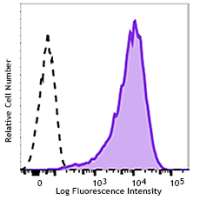-
Sign In
-

-
 Sony Biotechnology
Sony Biotechnology
-

-
 Sony Biotechnology
Sony Biotechnology
Brilliant Violet 711™ anti-human CD90 (Thy1)
Antibodies Single
Sony
5E10
Flow Cytometry
Mouse IgG1, κ
Human,Non-human primate
HEL cells
2240695
$220.00
Description
CD90 is a 25-35 kD GPI-anchored protein, also known as Thy-1. It belongs to the Ig superfamily. Human CD90 is expressed on neuronal cells, a subset of CD34+ cells, a subset of fetal liver cells and fetal thymocytes, fibroblasts, activated endothelial cells, and some leukemia cell lines. CD34+CD90+ cells are primitive hematopoietic stem cells. It has been reported that Thy-1 binds with β2 and β3 integrins and plays bimodal roles in the regulation of cell adhesion and neurite outgrowth, and inhibits hematopoietic stem cells proliferation and differentiation.
Formulation
Phosphate-buffered solution, pH 7.2, containing 0.09% sodium azide and BSA (origin USA).Recommended Usage
Each lot of this antibody is quality control tested by immunofluorescent staining with flow cytometric analysis. For flow cytometric staining, the suggested use of this reagent is 5 µl per million cells or 5 µl per 100 µl of whole blood. It is recommended that the reagent be titrated for optimal performance for each application.
Brilliant Violet 711™ excites at 405 nm and emits at 711 nm. The bandpass filter 710/50 nm is recommended for detection, although filter optimization may be required depending on other fluorophores used. Be sure to verify that your cytometer configuration and software setup are appropriate for detecting this channel. Refer to your instrument manual or manufacturer for support. Brilliant Violet 711™ is a trademark of Sirigen Group Ltd.
This product is subject to proprietary rights of Sirigen Inc. and is made and sold under license from Sirigen Inc. The purchase of this product conveys to the buyer a non-transferable right to use the purchased product for research purposes only. This product may not be resold or incorporated in any manner into another product for resale. Any use for therapeutics or diagnostics is strictly prohibited. This product is covered by U.S. Patent(s), pending patent applications and foreign equivalents.
References
1. McKenzie JL, et al. 1981. J. Immunol. 126:843.
2. Avalos AM, et al. 2002. Biol. Res. 35:231.
3. Wetzel A, et al. 2004. J. Immunol. 172:3850.


